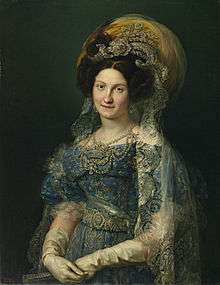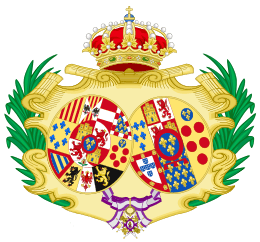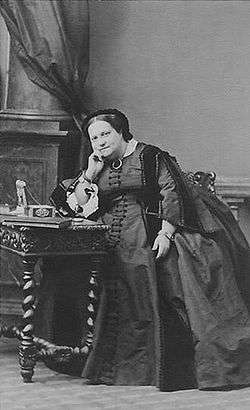Maria Christina of the Two Sicilies
| Maria Christina of the Two Sicilies | |||||
|---|---|---|---|---|---|
 Portrait by Vicente López y Portaña, 1830 | |||||
| Queen consort of Spain | |||||
| Tenure | 11 December 1829 – 29 September 1833 | ||||
| Regent of Spain during the minority of Isabella II | |||||
| Regency | 29 September 1833 – 1840 | ||||
| Predecessor | None | ||||
| Successor | Baldomero Espartero, duke of Vitoria, duke of Morella | ||||
| Born |
27 April 1806 Palermo, Kingdom of Sicily | ||||
| Died |
22 August 1878 (aged 72) Le Havre, French Third Republic | ||||
| Burial | El Escorial, Madrid, Spain | ||||
| Spouse | Ferdinand VII of Spain | ||||
| Issue among others... | |||||
| |||||
| House |
| ||||
| Father | Francis I of the Two Sicilies | ||||
| Mother | María Isabella of Spain | ||||
| Religion | Roman Catholicism | ||||
Princess Maria Christina of the Two Sicilies (Italian: Maria Cristina Ferdinanda di Borbone, Principessa delle Due Sicilie, Spanish: María Cristina de Borbón, Princesa de las Dos Sicilias; 27 April 1806 – 22 August 1878) was queen consort of Spain (1829 to 1833) and Regent of Spain (1833 to 1840).
Life
Born in Palermo, Sicily on 27 April 1806, she was the daughter of King Francis I of the Two Sicilies by his second wife, Maria Isabella of Spain.
Queen of Spain
With the death on 27 May 1829 of the third wife of Ferdinand VII of Spain, the Spanish king was in need for a male heir to succeed to the crown. This led to his fourth marriage, just seven months later (11 December 1829), to Maria Christina. As if the rushed marriage was not awkward enough, King Ferdinand was also her uncle by both birth and marriage. Maria Christina's mother, Maria Isabella, was King Ferdinand's sister; both were born to King Charles IV of Spain and his wife, Maria Luisa of Parma.
As queen, Maria Christina rapidly delivered two daughters, the future Queen Isabella (Isabel) II (1830–1904), and the Infanta Luisa Fernanda (1832–1897), and two sons who did not survive past one year.
Regency
When Ferdinand died on 29 September 1833, Maria Christina became regent for their daughter Isabella. Isabella's claim to the throne was disputed by her uncle, the Infante Carlos, Count of Molina, who claimed that his brother Ferdinand had unlawfully changed the succession law to permit females to inherit the crown (see Carlism). Some supporters of Don Carlos went so far as to claim that Ferdinand had actually bequeathed the crown to his brother but that Maria Christina had suppressed that fact. It was further alleged that the Queen had signed her dead husband's name to a decree recognizing Isabella as heir.
Carlos' attempt to seize power resulted in the Carlist Wars. Despite considerable support for Carlos from conservative elements in Spain, Maria Christina successfully retained the throne for her daughter. The Carlist Wars grew from a dispute about the succession into a dispute over the future of Spain. The supporters of Maria Christina and her daughter favored a liberal constitution and progressive social policies. In contrast, Carlos' supporters (called Carlists) favored a return to traditional society and an absolute monarchy. Ultimately, the army's loyalty to Isabella II proved the decisive issue in the war.
Downfall

On 28 December 1833, shortly after the death of Ferdinand VII, Maria Christina had secretly married an ex-sergeant from the royal guard, Agustín Fernando Muñoz (1808–1873). Maria Christina and Muñoz had several children together while trying to keep their marriage a secret.[1]
- Maria de los Desamparados, Countess of Vista Alegre (17 November 1834 - 19 August 1864) married Prince Władysław Czartoryski (1828–1894).
- Maria de los Milagros, Marchioness of Castillejo (8 November 1835 – 9 July 1903) married to Filippo del Drago, Principe di Mazzano e d'Antuni (1824–1913).
- Agustín Maria, 1st Duke of Tarancón (15 March 1837 - 15 July 1855) candidate to King of Ecuador in 1846.[2][3]
- Fernando Maria, 2nd Duke of Riansares and Tarancon (27 April 1838 – 7 December 1910) married to Eladia Bernaldo de Quirós y González de Cienfuegos (1839–1909).
- Maria Cristina, Marchioness of La Isabella (19 April 1840 – 19 December 1921).
- Juan Bautista, Count of Recuerdo (29 August 1841 – 2 April 1863)
- Antonio de Padua (3 November 1842 – 1847).
- Jose Maria, Count of Gracia (21 December 1843 – 17 December 1863)
Muñoz enlisted in the royal bodyguard, and attracted the attention of Maria Christina. According to one account, he distinguished himself by stopping the runaway horses of her carriage; according to another, he only picked up her handkerchief; a third explanation of his fortune has been given. Maria Christina's husband, King Ferdinand VII of Spain died on 29 September 1833, and on 28 December 1833 she and Muñoz were privately married.
If Maria Christina had officially made the marriage public, she would have forfeited the regency; but her relations with Muñoz were perfectly well known within the Spanish court. When on 13 August 1836 the soldiers on duty at the summer palace La Granja mutinied and forced the regent to grant a constitution, it was generally, though wrongly, believed that they overcame her reluctance by seizing Muñoz, whom they called her guapo, or fancy man, and threatening to shoot him.
Eventually, news of Maria Christina's marriage to this low-ranking soldier became public. That news made Maria Christina deeply unpopular. Her position was undermined by news of her remarriage and concerns that she was not actually supportive of her liberal ministers and their policies. Eventually, the army, which was the backbone of Isabella II's support, and the liberal leadership in the Cortes combined to demand that Maria Christina stand aside from the regency. In 1840 Maria Christina found her position intolerable; she renounced the regency and left Spain with Muñoz. The army commander, General Baldomero Espartero, Count of Luchana, replaced her as regent.
Exile

In 1842 Maria Christina purchased the Château de Malmaison as their residence. In 1843, on the overthrow of General Baldomero Espartero they returned to Spain. In 1844, Muñoz's stepdaughter Queen Isabella II was declared to be of age. On 23 June 1844 Isabella gave to Muñoz the title duque de Riánsares, to which was attached a Grandeza de España;[4] the title came from the river Riánsares, near Muñoz's birthplace in Tarancón. On October 12, 1844 Isabella gave official consent to the marriage between her mother and Muñoz, and it was publicly performed. In 1846 Isabella made Muñoz a Knight of the Golden Fleece. On 30 May 1846 she gave Muñoz a second title, marqués de San Agustín.[4] Muñoz was made a Captain General, the highest rank in the Spanish Army. In 1847 Louis Philippe, King of the French, gave Muñoz the title duc de Montmorot; he also invested Muñoz with the Grand Cross of the Légion d'honneur. In 1854, Maria Christina left for France a second time. France remained her primary residence for the remainder of her life.
In 1846, by the express request of the former president Juan José Flores, the Queen participated in an attempt to restore the monarchy in Ecuador. This two-phase plan was first that her son Agustín Muñoz of Bourbon should become King of Ecuador, and later in restorer of the Spanish monarchy in Perú and Bolivia, converting the child in the monarch of the tentative United Kingdom of Ecuador, Perú and Bolivia, with herself and Flores as Regents. When everything was organized, the attempt was denounced by the press and Latin American diplomats, and plans collapsed.[5][6]
Death and burial
Maria Christina's illness returned and she suffered from serious coughing, fainting and fever. She died in Le Havre, France on 22 August 1878. As the mother of Isabella II, Maria Christina was buried in the royal crypt of El Escorial monastery.
Ancestry
| Ancestors of Maria Christina of the Two Sicilies | ||||||||||||||||||||||||||||||||||||||||||||||||||||||||||||||||||||||||||||||||||||||||||||||||||||||||||||||||||||||||||||||||||||||||||||||||||||||||||||||||||||||||||||||||||||||||||||||||||||||||||||||||||||||||||||||||||||||||||||||||||||||||||||||||||||||||||||||||||||||||||||||||||||||||||||||||||||||||||||||||||||||||||||||||||||||||||||||||||||||||||||||||||||||||||||||||||||||||||||||||||||||||||||||||||||||||||||||||||||||||||||||||||||||||||||||||||||||||||||||||||||||||||||||||||||||||||||||||||||||||||||||||||||||||||||||||||||||||||||||||||||||||||||||||||||||||||||||||
|---|---|---|---|---|---|---|---|---|---|---|---|---|---|---|---|---|---|---|---|---|---|---|---|---|---|---|---|---|---|---|---|---|---|---|---|---|---|---|---|---|---|---|---|---|---|---|---|---|---|---|---|---|---|---|---|---|---|---|---|---|---|---|---|---|---|---|---|---|---|---|---|---|---|---|---|---|---|---|---|---|---|---|---|---|---|---|---|---|---|---|---|---|---|---|---|---|---|---|---|---|---|---|---|---|---|---|---|---|---|---|---|---|---|---|---|---|---|---|---|---|---|---|---|---|---|---|---|---|---|---|---|---|---|---|---|---|---|---|---|---|---|---|---|---|---|---|---|---|---|---|---|---|---|---|---|---|---|---|---|---|---|---|---|---|---|---|---|---|---|---|---|---|---|---|---|---|---|---|---|---|---|---|---|---|---|---|---|---|---|---|---|---|---|---|---|---|---|---|---|---|---|---|---|---|---|---|---|---|---|---|---|---|---|---|---|---|---|---|---|---|---|---|---|---|---|---|---|---|---|---|---|---|---|---|---|---|---|---|---|---|---|---|---|---|---|---|---|---|---|---|---|---|---|---|---|---|---|---|---|---|---|---|---|---|---|---|---|---|---|---|---|---|---|---|---|---|---|---|---|---|---|---|---|---|---|---|---|---|---|---|---|---|---|---|---|---|---|---|---|---|---|---|---|---|---|---|---|---|---|---|---|---|---|---|---|---|---|---|---|---|---|---|---|---|---|---|---|---|---|---|---|---|---|---|---|---|---|---|---|---|---|---|---|---|---|---|---|---|---|---|---|---|---|---|---|---|---|---|---|---|---|---|---|---|---|---|---|---|---|---|---|---|---|---|---|---|---|---|---|---|---|---|---|---|---|---|---|---|---|---|---|---|---|---|---|---|---|---|---|---|---|---|---|---|---|---|---|---|---|---|---|---|---|---|---|---|---|---|---|---|---|---|---|---|---|---|---|---|---|---|---|---|---|---|---|---|---|---|---|---|---|---|---|---|---|---|---|---|---|---|---|---|---|---|---|---|---|---|---|---|---|---|---|---|---|---|---|---|---|---|---|---|---|---|---|---|---|---|---|---|---|---|---|---|---|---|---|---|---|---|---|---|---|---|---|---|---|---|---|---|---|---|---|---|---|---|---|---|---|---|---|---|---|---|---|---|---|---|---|---|---|---|---|---|---|---|---|---|---|---|---|---|---|---|---|---|---|---|---|---|---|---|---|---|---|---|---|---|---|---|---|---|---|---|---|---|---|---|---|---|---|---|---|---|---|---|---|---|---|---|---|---|---|---|---|---|---|---|---|---|---|---|---|---|---|---|---|---|---|---|---|---|
| ||||||||||||||||||||||||||||||||||||||||||||||||||||||||||||||||||||||||||||||||||||||||||||||||||||||||||||||||||||||||||||||||||||||||||||||||||||||||||||||||||||||||||||||||||||||||||||||||||||||||||||||||||||||||||||||||||||||||||||||||||||||||||||||||||||||||||||||||||||||||||||||||||||||||||||||||||||||||||||||||||||||||||||||||||||||||||||||||||||||||||||||||||||||||||||||||||||||||||||||||||||||||||||||||||||||||||||||||||||||||||||||||||||||||||||||||||||||||||||||||||||||||||||||||||||||||||||||||||||||||||||||||||||||||||||||||||||||||||||||||||||||||||||||||||||||||||||||||
References
- ↑ José María Zavala: Bastardos y Borbones: Los hijos desconocidos de la dinastía Retrieved 25 January 2016.
- ↑ Ralph W. Haskins, "Juan José Flores and the Proposed Expedition against Ecuador, 1846-1847"
- ↑ The Hispanic American Historical Review 27, no. 3 (August 1947): 467-95. Camilo Destruge, La expedición Flores: Proyecto de monarquia americana, 1846-47 (Guayaquil: Impr. de el Tiempo, 1906).
- 1 2 Elenco de Grandezas y Títulos Nobilarios Españoles. Madrid: Ediciones Hidalguia, 1996; ISBN 84-87204-84-8.
- ↑ Orrego Penagos, Juan Luis. "The general Juan José Flores and Perú". Rumbo al Bicentenario. December 2003. Retrieved April 17, 2015.
- ↑ Garibaldi de Mendoza, Rosa (June 28, 2009). "When Ecuador almost became a Kingdom". El Comercio of Perú Newspaper. Retrieved April 17, 2015.
- Encyclopædia Britannica
- Two Sicilies family tree at the Wayback Machine (archived March 17, 2006)
- Genealogical information at thepeerage.com
External links
![]()
Maria Christina of the Two Sicilies Cadet branch of the House of Bourbon Born: 27 April 1806 Died: 22 August 1878 | ||
| Spanish royalty | ||
|---|---|---|
| Vacant Title last held by Maria Josepha Amalia of Saxony |
Queen consort of Spain 11 December 1829 – 29 September 1833 |
Vacant Title next held by Francis, Duke of Cádizas King consort of Spain |
| Political offices | ||
| Vacant Title last held by Pedro de Alcántara Álvarez de Toledo |
Regent of Spain 29 September 1833 – 12 October 1840 |
Succeeded by Baldomero Espartero |